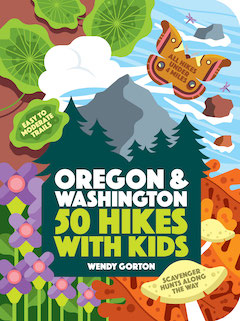Book Review
50 Hikes with Kids: Oregon and Washington
Wendy Gorton.2018. ISBN:978-1-60469-800-8.
Timber Press, Portland, OR.
Softcover, 280 pp. $19.95

50 Hikes with Kids: Oregon and Washington, an attractive guidebook for adults seeking advice for helping children explore the outdoors, is filled with colorful and informative graphics, interesting pictures, and clear maps. Additionally, the weatherproof cover protects it in wet weather and its rounded corners makes it easy to slip in or out of a backpack.
As an outdoor educator and outdoorswoman, Wendy Gorton has extensive experience interacting with children in the outdoors. In the preface, she states the aim of the book is to inspire a love for the outdoors in children and to give their “adults some tools to help ignite questions on the trail.” My wife and I take our two small children out on trails and/or camping most weekends between April and September, so I was eager to learn what Ms. Gorton could offer us. After reading this book, I commend the author for her nuanced and thoughtful approach to shepherding children on the trail and instilling in them a love of nature and history.
The “Choosing Your Adventure” section organizes the 50 hikes first by state, secondly by features (lakes, waterfalls, history, flora, fauna, geology, caves, etc.), and thirdly by season. This organization allows selection of hikes using different priorities, while each entry provides detail that shows the author has obviously visited the locations.
The next section, “Preparing for Your Adventure,” contains valuable information about safety, gear, levels of difficulty and access to trails, descriptions of terms used in the book, and more. She provides suggestions for adding excitement and interest to hikes, such as by encouraging children to create stories about plants and animals they find and providing links to websites and to apps that describe how to enhance hikes without undue distraction. With intelligence and sensitivity, the author describes the how-to, and value of, nature journaling, the appropriateness (or inappropriateness) of smartphone use, and the importance of teaching children to respect nature.
The “meat” of the book is the “Adventures” section that describes the 50 hikes. They are well organized by state and region and illustrate the author’s understanding of what would interest children on each hike, and what is valuable information for an adult hiking with children (e.g., length, difficulty, elevation, maps and directions, nearby towns and food, jurisdiction and land management agency contacts). Pictures are compositionally great. The scavenger hunts, with photos and descriptions of a variety of plants, animals, and geographic features, provide history and natural history lessons to parents and children alike.
Unfortunately, sometimes the botanical information listed for the “Scavenger Hunts” is incorrect (I did not review the other categories of natural history). For example, American smokebush (Cotinus obovatus) is described as growing along the Wenatchee River in the Tumwater Canyon; this species is native to the southeastern United States. It appears that the author mistook it for the native red osier dogwood (Cornus sericea), which is shown in the accompanying photo. The Majestic Falls scavenger hunt features red-osier dogwood, but the accompanying photo is salal (Gaultheria shallon). Dull Oregon grape (Mahonia nervosa) is properly described in that hike, but several pages later (Upper Trestle Creek Falls) Oregon grape appears as the photo for scarlet sumac (Rhus glabra), which is out of range in northwestern Oregon. In the Todd Lake scavenger hunt, subalpine fir (Abies lasiocarpa) is illustrated by a photo of lodgepole pine (Pinus contorta). There are other examples, but I won’t list them all.
This book is thoughtful and well-written and will probably be most valuable to two categories of adult caregivers: parents who have little or no outdoor experience of their own or caregivers who have a knowledge of nature but less experience with inspiring children (e.g., relatives without children of their own). Although those living in the vicinity of the bulk of the 50 hikes may find it most useful, the author’s intent was to give adults everywhere the scaffolding needed to build their own experiences on local trails. I imagine NPSO members with children who are already comfortable outdoors might consider it as gift for those with less experience either with children or natural history (or both). Perhaps a second edition will correct the botanical errors.
- Dominic Maze, Portland Chapter

